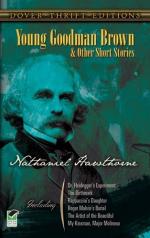|
This section contains 1,265 words (approx. 5 pages at 300 words per page) |

|
SOURCE: “‘Young Goodman Brown’—Warning to Idealists,” in American Transcendental Quarterly, Vol. 14, Spring, 1972, pp. 156-58.
In the following essay, Erisman suggests that in “Young Goodman Brown” Hawthorne wanted to point out the psychological and social dangers of “excessive innocence.”
Readings of Nathaniel Hawthorne's “Young Goodman Brown” (1835) focus almost exclusively upon its dual evocation of Calvinism and demonism. The Puritanic gloom and the Satanic gleam that permeate the story are so obviously significant, in fact, that one scholar has virtually denied the possibility of any other readings.1 There is, however, persuasive evidence that Hawthorne had more than Puritans and witches in mind as subjects for his tale. Indeed, his treatment of Young Goodman Brown himself, of the curious nature of faith, and of the effects of the loss of faith, taken in the context of Hawthorne's intellectual development in the years immediately prior to 1835, points to the conclusion that...
|
This section contains 1,265 words (approx. 5 pages at 300 words per page) |

|


